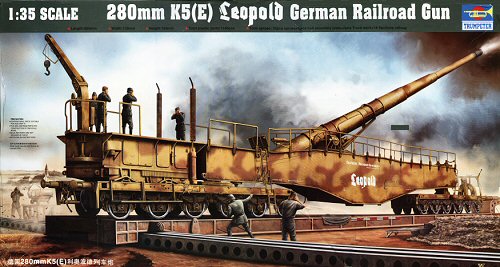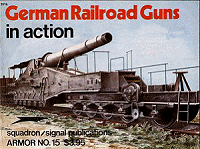

280mm K5(E) 'Leopold'
German Railroad Gun
1:35 Kit No. 00207
First Look Review by Terry Ashley



The kit:
The kit comes in a large box measuring 635mm (25in), 335mm (13.5in)
and 170mm (6.75in) deep and this is filled with 1140 parts in light grey plastic,
an etched
fret with 27 pieces, two lengths of copper wire, a length of fine chain, two
metal shafts plus a short section of plastic tube, a sheet of mesh, thin twine
and poly caps to hold the truck wheels in place. There is also the decal sheet
and a large 44 page instruction sheet to finish off what is an impressive list
of parts.
The quality of the moulding is excellent and Trumpeter just keep improving
on this aspect, the plastic used is slightly ‘softer’ compared
to that used in by some other manufacturers and this helps in both removing
the parts from the sprues and working with the parts.
There are many small parts in the kit and these are moulded with excellent
fine crisp details, pin ejector marks are kept to a minimum on most parts
and there are small ‘nodes’ of extra plastic used as the pop out
points instead of causing blemishes on the smaller parts themselves. This
does mean you have a little more cleanup but this is a small price for the
cleaner details. There are a few parts with pin marks needing attention but
these are mostly unavoidable and won’t take too much trouble to remove.
On the larger parts the pin ejector parts are mostly in areas not seen after
assembly, but there are a few parts where detail is on both sides and the
pin marks are again unavoidable but should be fairly easy to remove and the
mould seam lines on most parts is only minor and on a par with other major
manufacturers.
Packaging:
With so many large and small parts in the box it is worthwhile looking at
the packaging as this can help to reduce any part damage in transit if done
properly.
Inside the main box are three smaller boxes, one containing all the track
bed sections, one with the extra bits such as the decal sheet, etched and
metal parts. The third has the four full length hull sides each separated
with another piece of cardboard inside the box. 12 thin plastic bags for the
sprues take up the rest of the box and some of these have additional cardboard
and padding taped to the sprues to protect vulnerable parts such as the thin
full length safety rails along the top of the hull. Clearly some thought has
gone into the packaging not only to reduce damage but to get all the parts
into the box and with only two parts slightly damaged in my sample out of
over 1100 is
not an bad job.
Rail trucks:
The two rail trucks are superbly detailed with approximately 750 parts making
up the two. The suspension is all separate parts from the leaf spring mounts,
the leaf springs themselves and the attachment linkages to the cross members
and other details. The wheels are held in place on the axles by poly-caps
allowing them to rotate while the axle hubs are made up of four parts each.
The upper decks are one large moulding with excellent details included plus
a multitude of other small details including some etched parts and multi-part
coupling linkages on separate truck end plates. Using templates in the instructions
as a bending guide wire brackets are added to each truck end and considering
some recent large vehicle kits have less parts it gives an idea of the details
included in the two trucks.


The main chassis itself has the two outer and inner side panels as separate
parts with the top and bottom full length edge panels also separate parts,
due to the good packaging all these large flat parts were perfectly straight
without any hint of warping which can easily happen with parts of this type.
The barrel and elevation assemblies plus the front and rear bulkhead assemblies
are trapped between the two inner side panels to form a very rigid assembly.
The two trunnion supports on each side of the upper chassis are made up of nine parts each plus a couple of etched detail parts. Once the main chassis and internal assemblies have been assembled there are many smaller detail parts to be added such as the top decks which features the wood planking and shell trolley rails on the rear section, front barrel lock, shell loading tray (which is movable) and boarding ladders on the front end plate.
The remaining barrel length is made up of four parts with a separate muzzle cap with rifling added to the insides and this all fits into the end of the previously assembled breech and support assembly.
The left side control panel has a separate cover and added details
along with the fold out stand with mesh cut to size for the tread plate (strangely
not included as an etched part?), and you have a choice of extended or folded
side crew ladders.
The two full length safety rails along the hull top are very thin and you
will have to take care when removing these from the sprues and fitting in
place, the softer plastic used helps here by allowing these to bend slightly
without snapping as with harder plastic. The fine chain included is used to
connect the gaps in the railing over the crew steps and between the main hull
and rear engine compartment.
Rear engine compartment:
The rear diesel engine compartment/loading platform is labelled incorrectly
in the instructions as the “Ammunition wagon”, this aside this
compartment is again made up of all separate side, bottom and top panels
with nice crisp details included.
The top section which includes the wood panelling and small rails for the
shell trolley also includes the extension that connects to the rear of the
main chassis. If you wish to display the model in travel mode this extension
is cut off and glued in the folded position on the front of the compartment.
Added to the compartment is many smaller detail parts such as side supports,
storage boxes with added etched parts plus compartment door handles, exhaust
pipes and additional etched brackets.
The two exhaust stacks have etched heat shields provided as well as a length
of plastic rod to use as a jig to bend the shields to the correct diameter
(use the rod like a rolling pin to get the etched parts to “roll” around
the rod) plus the small round etched top and bottom sections of the resulting
etched tube.
The large shell handling crane is added to the rear of the upper deck and
is again a well detailed assembly with a couple more etched parts added, the
winch mechanism is made up of ten parts with the thread provided for the winch
cable and the lower crew stands have etched tread plate panels provided. The
safely rails for the crew stand are extremely thin and again will need care
when removing from the sprues and attaching to the stand and the small shell
trolley has separate wheels and top shell cradle.
Also included are two 28cm shells with stencilling on the decal sheet and two shell cases to use on the shell trolley or cradle as you wish.
Rail sections:
You are provided with two alternative rail sections to sit your K5 on; one
is a straight section of track made up of the bed sections and track lengths
provided while the other is a right angle cross section with small turntable
at the junction.
The straight section of track is easy to assemble and takes up less room (if
a kit nearly 1 metre long can use less space?), while you will need some serious
display area for the cross track section. The cross track section as included
in the kit was one of the options for the gun, reference for this can
be found in the book Eisenbahn-Geschütze
der welt (Railway Guns of the
world) by Franz Kozer published by Motor bach Verlag, see reference section
below.
Decals:
The decals are well printed with thin carrier film and as the markings are
all in white I suppose you could say the register is good. As well as the
large name “Leopold” there is a selection of stencilling for
around the hull. There appears to be some misspelling of some of the smaller
stencilling but as the offending words are only 1mm in height they shouldn’t
be that noticeable.

Instructions:
The instruction booklet has 44 pages with very clear line drawings of the
kit construction. Although there are over 1100 parts I didn’t find
any section of the instructions confusing, obviously you have to carefully
read and understand them before assembly as with any instructions. The painting
guide gives two examples, one in the Dark Yellow/Red Brown scheme as seen
on the Aberdeen K5 and the other in overall Panzer Grey of a K5 at Calais
France in 1941. Paint numbers are given for Testers MM, Polly
Scale and
Gunze Sangyo paints as well as the RAL paint numbers so it will be possible
to match these with other brand paints if required.
See Instruction sheets (Will
open in new window, only close that window when you have finished navigating
through the pages.)
Conclusion:
This is a superbly detailed kit with many fine and delicate parts as well
as large mouldings with equally good details. Obviously with over 1100 parts
you are not going to put this together overnight but with the clear instructions
it should all go smoothly. The details are everywhere from the intricate
rail trucks to the main gun and elevation mechanism to the rear engine compartment
as well as a choice of rail layout.
The built kit has an overall length of 959mm (37.75in) and will no doubt look
most impressive and continues the trend from Trumpeter of improving the quality
with each new release.
Highly recommended.
Trumpeter have also released a set of eight K5 Crew Figures see a full review here.
The Sprues:
Note: Some images are scanned in multiple segments due to the size of the
parts and this may result in some image distortion, thank you.














Click here for a Comparison Review between this and the Dragon 28cm K5(E) Leopold Railway Gun.
References:


Page created 1 August 2003
Page updated 4 August 2003